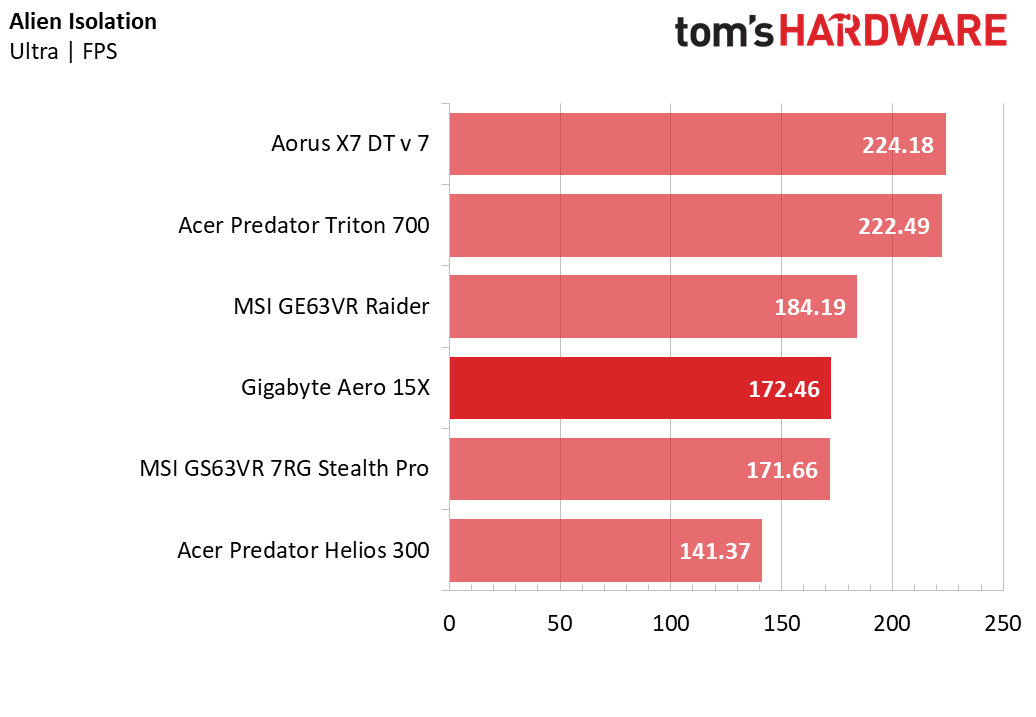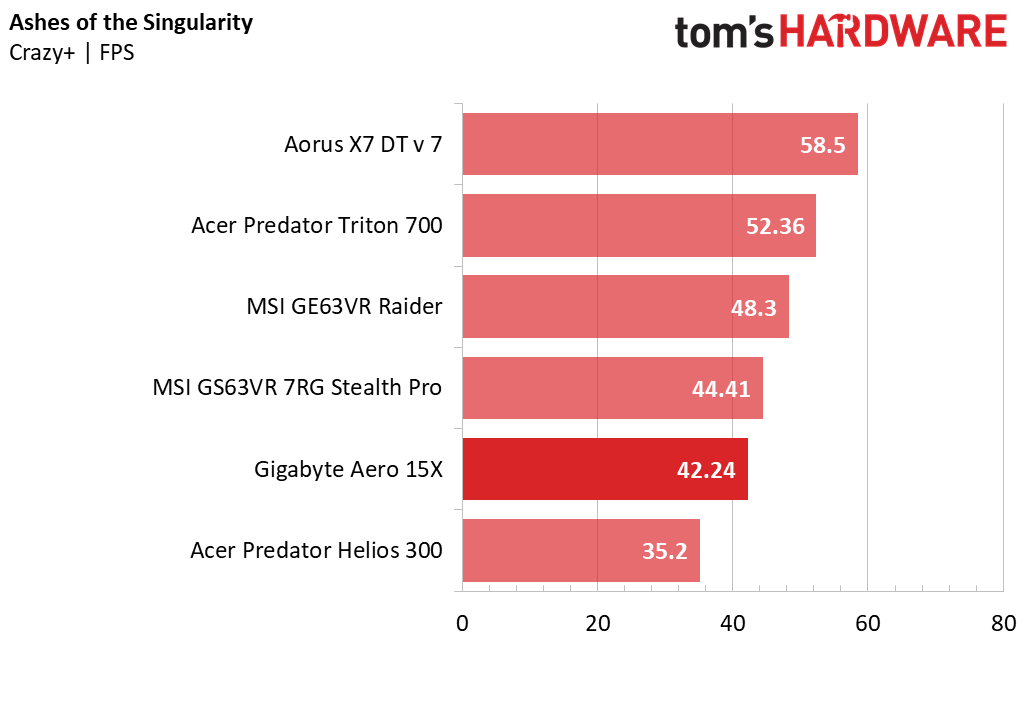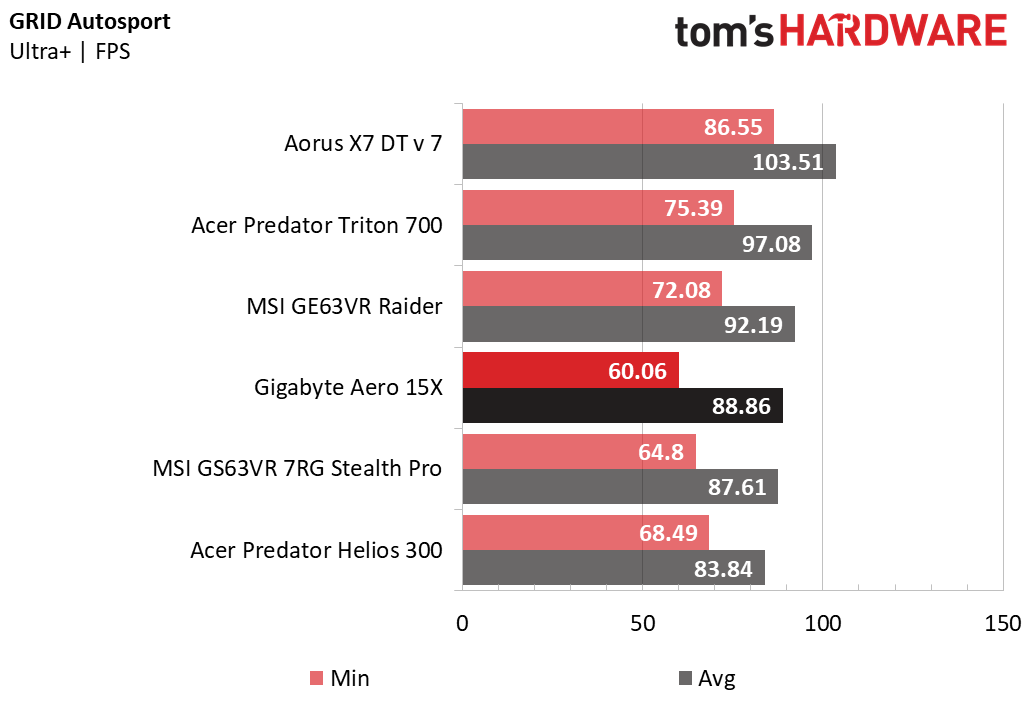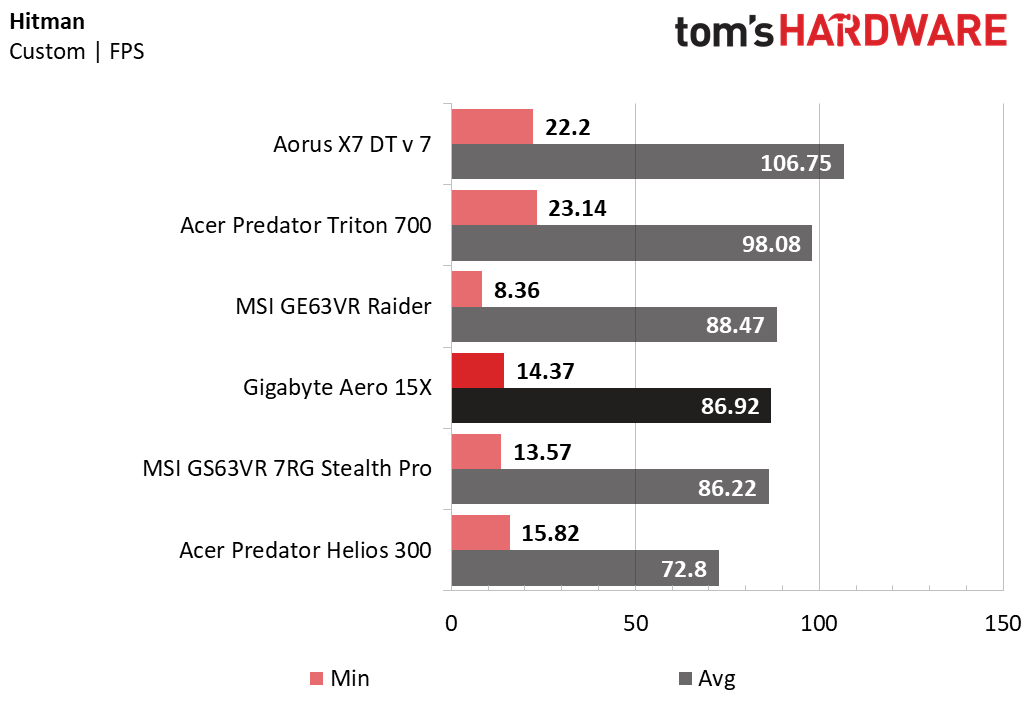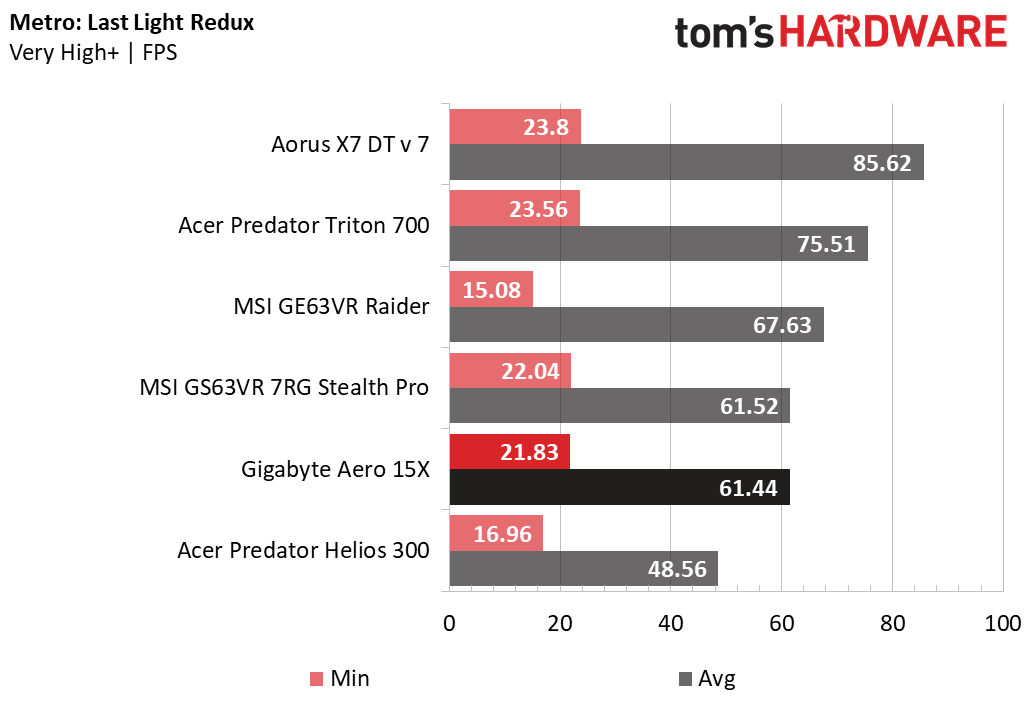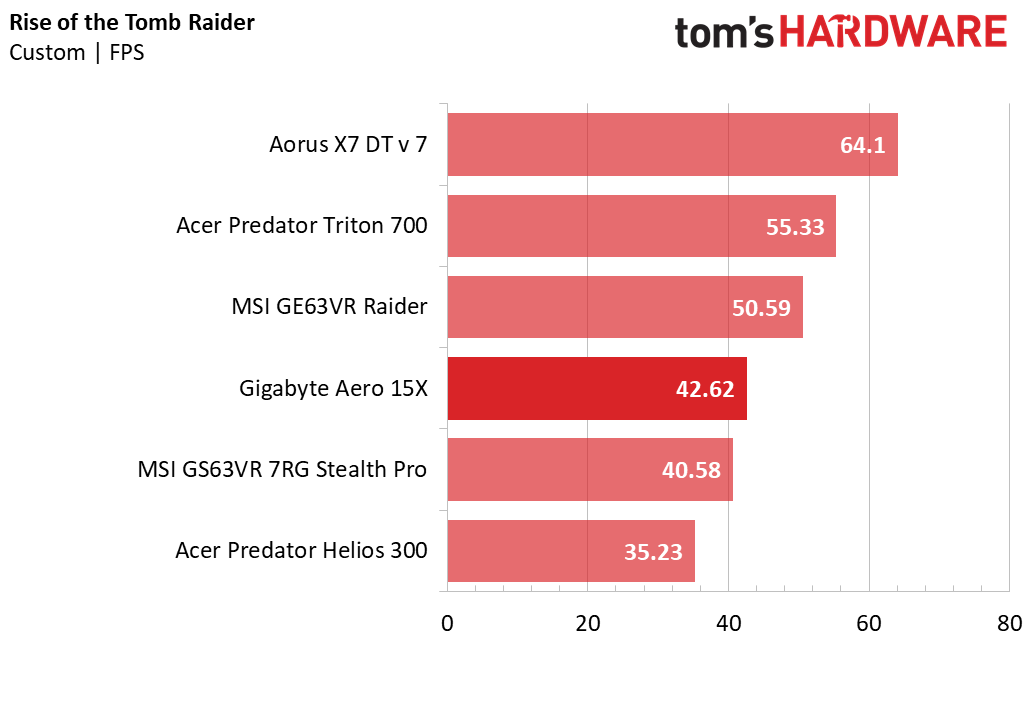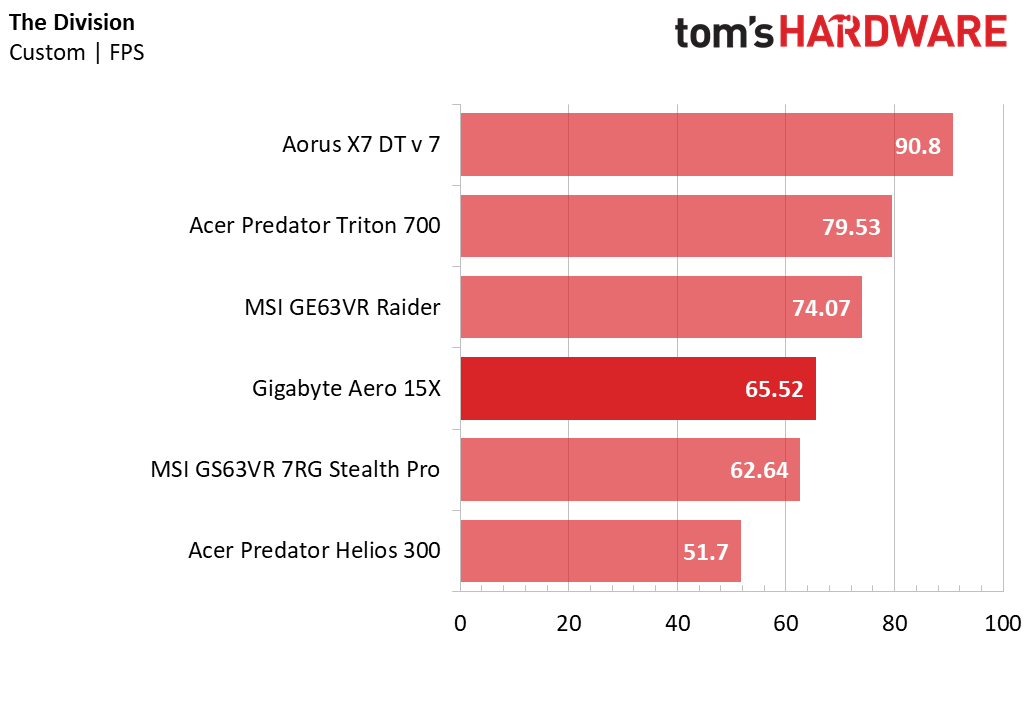Gigabyte Aero 15X Max-Q Gaming Laptop Review: The Best Max-Q Laptop Yet
Why you can trust Tom's Hardware
Gaming Benchmarks
Alien Isolation
Alien Isolation is one of easier-to-run titles in our game suite, and we've found that even affordable laptops with low graphics power can maintain outstanding frame rates here. Therefore, it should come as no surprise that the Gigabyte Aero 15X absolutely blows Alien Isolation's benchmark workload out of the water with an impressive 172 FPS. It's situations like this in which gamers can take advantage of high-refresh-rate displays. Unfortunately, the Aero 15X doesn't offer such a luxury, and its frame rate is essentially capped at 60 FPS, producing the same visual results as the much more affordable Acer Predator Helios 300.
Ashes of the Singularity
Ashes of the Singularity is an extremely demanding game, and we haven’t quite found a system that can maintain over 60 FPS at high resolutions, including the Aorus X7 DT v7. The Aero 15X just struggles to deliver 40 FPS. The MSI Raider and its unrestricted GTX 1070 doesn't fare much better, delivering just below 50 FPS. If you want to play Ashes of the Singularity at a respectable frame rate, you'll need to dial down the graphical settings, even if you have a GTX 1080-based laptop like the Aorus.
DiRT Rally
DiRT Rally is a platform-based title best played on a well-balanced system.The Max-Q GTX 1070 offers enough performance to reach the 60 FPS sweet spot with plenty of performance to spare. In comparison, the Acer Helios falls behind by 20%, resulting in a frame rate well below 60 FPS. The MSI Stealth Pro runs a couple of frames slower, but it can take advantage of its 120Hz refresh rate by lowering the graphical settings. Similarly, the Raider, Triton, and Aorus can achieve smoother visuals, thanks to their stronger GPUs and higher refresh rates.
Grand Theft Auto V

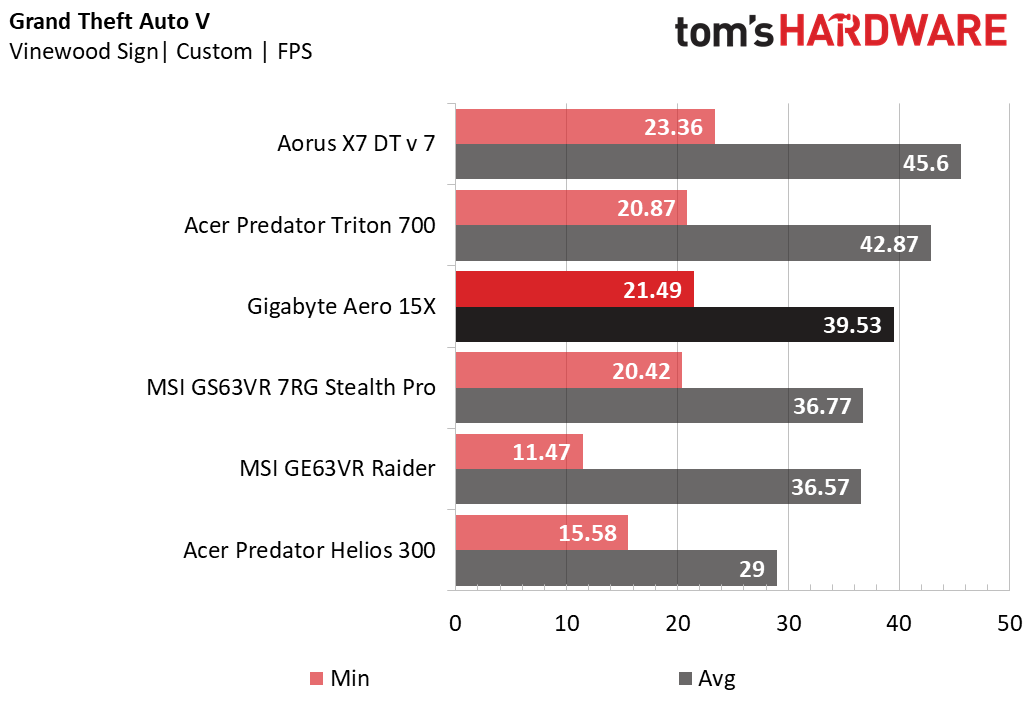
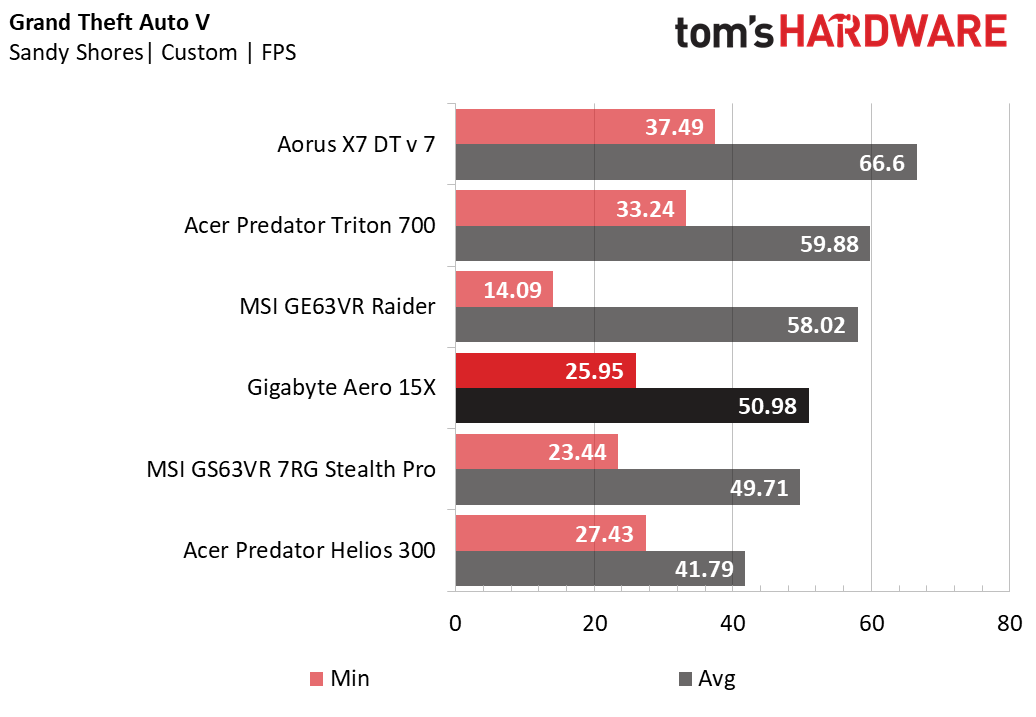
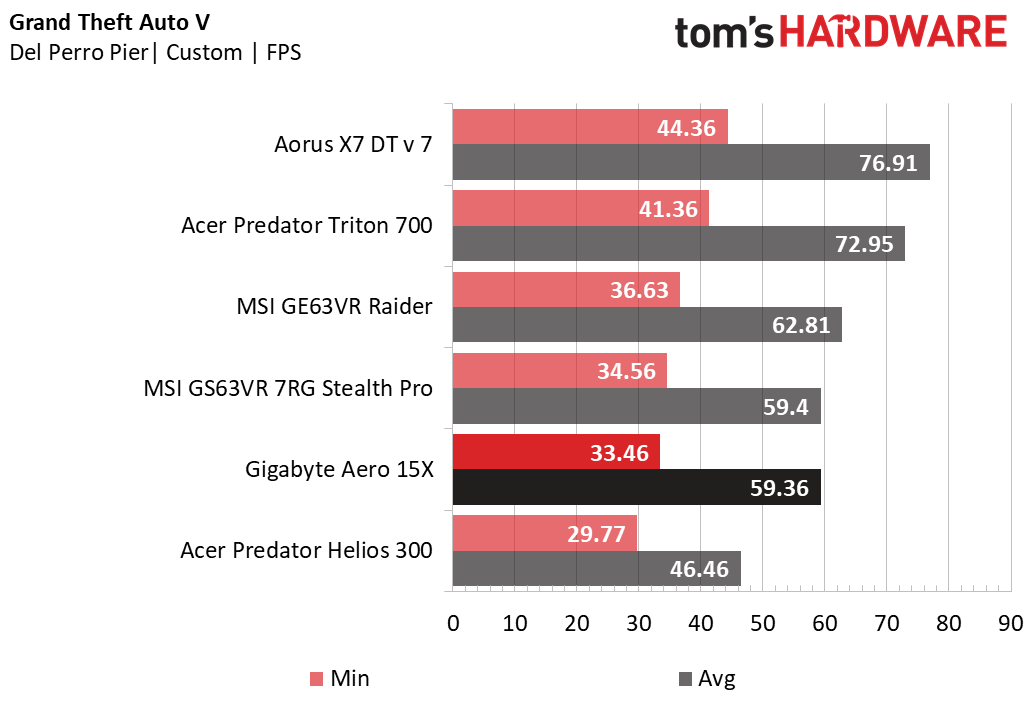
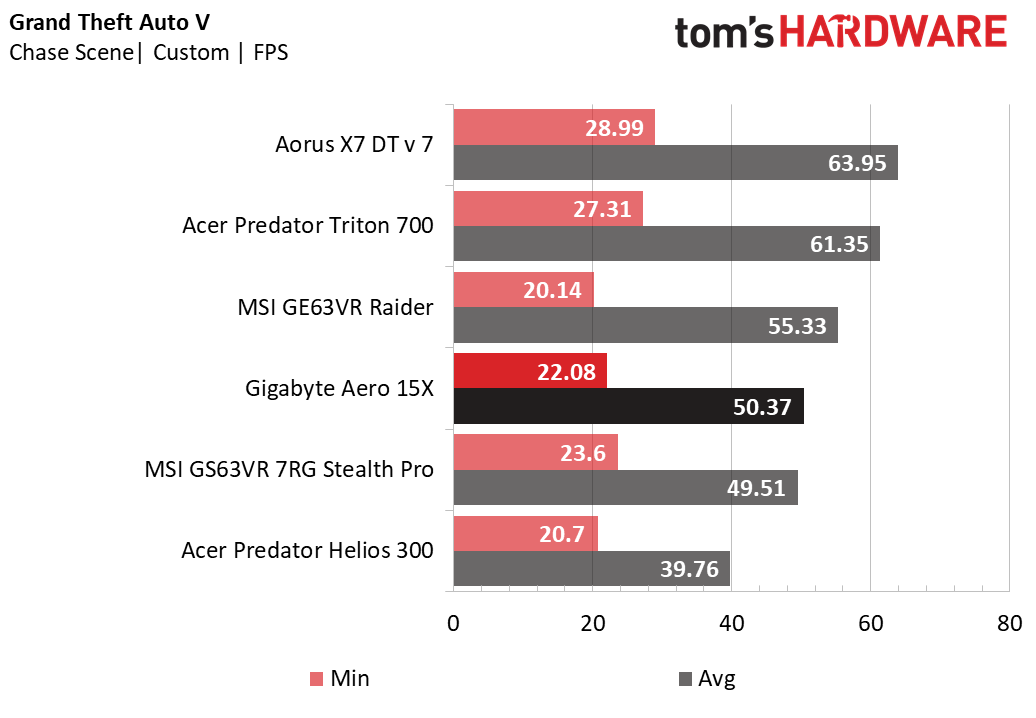
Grand Theft Auto V is one of the more demanding titles in our suite, so you would think that a Max-Q GPU would lose out significantly against a traditional GPU. On the contrary, the Aero 15X offers competitive performance against the MSI Raider. The biggest performance loss is during the Sandy Shores scene, where the Aero 15X experiences a 12% lower frame rate against the Raider. In all other cases, the frame-rate difference is well below 10%, and the Aero 15X even outperforms the Raider by 3 frames during the Vinewood Sign scene. However, the GTX 1070, Max-Q or otherwise, still isn't enough to maintain 60 FPS consistently in Grand Theft Auto V.
GRID Autosport
GRID Autosport offers a workload similar to DiRT Rally in that they are both platform-based racing titles, although GRID is much less demanding. GRID is notable for giving GPUs with high clock rates a noticeable edge, meaning even a low-end gaming laptop can give more expensive laptops a run for their money. As such, the Helios 300, whose GTX 1060 has a maximum boost clock of 1670MHz, only performs about 6% slower than the Aero 15X, whose Max-Q GTX 1070 has a max boost clock of 1379MHz. In fact, the Helios only runs slower than the MSI Raider by 9% because the latter's GTX 1070 has a max boost clock of 1645MHz.
Hitman
Hitman's graphical workload is similar to that of GRID Autosport, but without the clock-rate quirk. Performance is primarily limited to that of the CPU platform, so additional GPU horsepower won't offer a significant improvement. The frame-rate difference between an Aero 15X and an MSI Raider is less than 2 frames, and the Triton 700 performs only 13% faster than the former. On the lower end, the Acer Helios falls behind the Aero 15X by only 16%, and it still delivers well over 60 FPS. However, as stated previously, the Aero 15X is held back by its 60Hz refresh rate, while competing systems can reduce their settings to approach 120 FPS.
Metro: Last Light Redux
Most of our game benchmarks have been platform-based, but Metro: Last Light Redux provides contrasting results because of its GPU-heavy workload.
Get Tom's Hardware's best news and in-depth reviews, straight to your inbox.
As a result, we find a slight gap between the Max-Q Aero 15X and the Raider's standard GTX 1070. The performance loss is around 10%, bringing the Aero 15X's performance just over 60 FPS. If 60 FPS is your endgame, then the Aero 15X will serve you just fine; a lower-end laptop such as the Acer Helios won't come close, running around 13 FPS slower than the Max-Q GTX 1070 laptops, thus landing it well below 60 FPS. On the opposite end, if you have a high-refresh-rate display, you're better off investing in a more powerful system such as the Triton 700 or Gigabyte's own Aorus X7.
Rise of the Tomb Raider
Rise of the Tomb Raider is another GPU-intensive title, demanding more GPU performance than Metro. A standard GTX 1080 is capable of meeting these requirements, meaning the Aorus X7 is the only system capable of maintaining a solid 60 FPS. Anything lower than that will deliver sub-60-FPS performance, even if it's a Max-Q version of the GTX 1080. Obviously, this doesn't bode well for our Aero 15X; it delivers 42 FPS at these settings, a 19% drop in comparison to the MSI Raider, whose standard GTX 1070 provides enough GPU horsepower to hit 50 FPS. Still, this is much better than the Acer Helios, whose frame rate drops into the mid-30s.
The Division
The Division is yet another graphics-heavy title, although not to the extent that RotTR is. The graphics demands don't play well with Max-Q's power restrictions, resulting in a 13% frame rate difference between the Gigabyte Aero 15X and the MSI Raider. Luckily, the Max-Q GTX 1070's output is enough to satisfy our 60 FPS standard. The Max-Q GTX 1080 exhibits a similar performance difference, with the Aorus performing 14% faster than the Acer Triton. So long as you have a GTX 1070 of some sort, you'll be able to reach 60 FPS.
Thief
In contrast to the last three heavy hitters, Thief is a relatively light title that is CPU-bound; the Acer Helios, the lowest-end system in our roundup, is capable of well over 60 FPS, and any additional performance is just icing on the cake. The Gigabyte Aero 15X delivers close to 100 FPS, but like we stated before, much of this performance goes to waste with its 60Hz refresh rate. The Stealth Pro, Raider, Triton, and Aorus all deliver similar or better performance, but with the added benefit of a 120Hz refresh rate. They're well within reach of 120 FPS, too, so only light tweaking is needed to maximize their potential.
MORE: Best Gaming Laptops
MORE: Gaming Laptop Previews
MORE: All Laptop Content
Current page: Gaming Benchmarks
Prev Page Synthetic Benchmarks Next Page Battery, Thermal & Display Testing-
anbello262 In the first page, display section:Reply
20790851 said:The Aorus targets the sweet spot with a QHD (2560x1440) matte TN display with a 120Hz refresh rate.
1- Isn't this the Aero?
2-In the last page:
Cons
•Somewhat bland aesthetics
•Thicker than most Max-Q laptops
•60Hz refresh rate
Where is the mistake? -
AgentLozen I'm only on the first page, but I found if I CTRL + F the term "Aorus", I get several hits. It's always used in an undefined context. "Aorus" is never introduced to us (at least on the first page of the article).Reply
Also, at the top of the page, the laptop is said to be configured with a "15.6-inch FHD (1920x1080), Anti-Glare, IPS, X-Rite Pantone Certified" display. I don't know if a 120Hz TN panel is optional, but like Anbello262 said earlier, there seems to be a mistake somewhere.
Edit: There is a mention of a GTX 1080 in one of the earlier paragraphs, but I think that relates back to the Aorus issue. -
AgentLozen I finished reading the article and I like the Aero 15's no-nonsense approach to it's design. As a non-teenager, mature adult, I don't want obnoxious LEDs lining my laptop or a big orange, red, and yellow dragon breathing blinking LED fire with the phrase "THIS LAPTOP WILL KICK YOUR GAME'S BUTT" highlighted with rainbow LED arrays on the laptop case. I always complain about this whenever a product that features EXTREME LED lighting gets reviewed. Look like Gigabyte saw my posts here and built a laptop with an adult aesthetic in mind.Reply
In the laptop comparison, I wish you guys would have included the Asus ROG Zephyrus Max-Q GX501VS-XS71 that was reviewed back in February. You gave that a glowing review back then and I wish I could have been an "ASUS v Gigabyte" section on the conclusion page.
Thanks for the review guys. -
g-unit1111 I was very close to buying a Gigabyte Aero, but the high price and lack of any sort of mass storage drive was definitely not ideal. The deal breaker for me was the 60Hz screen, where the MSI laptop that I ultimately wound up buying was cheaper with an additional mechanical HD and a 120Hz screen.Reply -
justin.m.beauvais I've really liked everything I've seen about the Gigabyte laptops. They look good, as the plain yet premium design really appeals to me, and they seem to be quality systems. I was recently in the market for a gaming laptop and seriously considered one, but ultimately it was the price that disqualified it for me. I decided to go with the Helios 300 as it was a very reasonable price, with reasonable hardware, and I spent the difference on a storage SSD, VR HMD, and some more games. When it came down to it, I just couldn't justify the price of the Aero lineup compared to what you get elsewhere. If you've got the money, the Aero would be the way to go, but on a budget there are better deals.Reply
